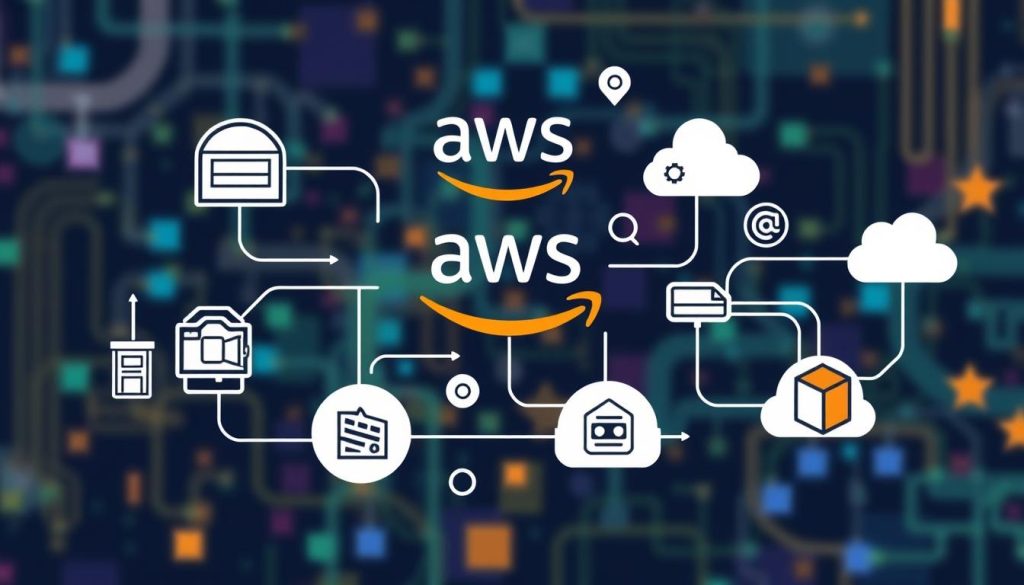AWS DevOps Test: Continuous Delivery & Automation
In today’s fast-paced cloud computing world, delivering software updates quickly and automating processes is key. The AWS DevOps Test: Continuous Delivery & Automation checks if you know the latest DevOps tools and practices. It focuses on making CI, CD, and infrastructure automation work together smoothly.
This test dives deep into AWS CodePipeline and AWS CodeDeploy. It teaches you how to create efficient cloud deployment pipelines. You’ll learn about continuous integration and deployment. This helps you make your software delivery process faster and more reliable.

Key Takeaways
- Gain expertise in AWS CodePipeline and AWS CodeDeploy for seamless CI/CD workflows
- Understand the concepts of continuous integration and continuous deployment
- Learn to automate infrastructure provisioning using AWS CloudFormation
- Master DevOps best practices and tools for efficient cloud deployment
- Enhance your ability to streamline the software delivery lifecycle
Mastering AWS DevOps (Continuous Delivery and Process Automation) Test
In today’s software world, continuous integration (CI) and continuous deployment (CD) are key. They are at the core of DevOps, making build, test, and deployment smoother. Learning these skills can make your software delivery fast and reliable.
Understanding Continuous Integration and Continuous Deployment
Continuous integration means regularly updating code in a central spot. It builds and tests the code automatically. This catches bugs early, keeping the software ready to ship.
Continuous deployment goes further by automating code updates to production. This means faster and more frequent releases.
Exploring AWS CodePipeline and AWS CodeDeploy
AWS has tools like AWS CodePipeline and AWS CodeDeploy for CI/CD. CodePipeline automates your delivery process, working with tools like Git and Jenkins. CodeDeploy makes deploying apps to services like Amazon EC2 and AWS Lambda easy.
Using these AWS services, you can create strong CI/CD pipelines. They help you update your apps quickly and reliably.
| AWS DevOps Tool | Key Functionality |
|---|---|
| AWS CodePipeline | Orchestrates end-to-end automation for your software delivery process |
| AWS CodeDeploy | Automates the deployment of your applications to various computing services |

Streamlining Infrastructure as Code with AWS CloudFormation
In the fast-paced world of cloud computing, infrastructure as code (IaC) has changed how DevOps teams manage resources. AWS CloudFormation leads this change. It lets you create and manage your cloud infrastructure with code.
AWS CloudFormation makes it easier to set up and manage your cloud resources. You can treat them as reusable assets. Instead of setting up each part manually, you can use a CloudFormation template. This template outlines your desired infrastructure, like EC2 instances and databases.
Using infrastructure as code makes your cloud automation smoother. It ensures your deployments are consistent. This saves time, reduces errors, and promotes a culture of DevOps practices and configuration management.
CloudFormation also works well with other AWS DevOps tools, like AWS CodePipeline and AWS CodeDeploy. This integration helps build strong cloud automation pipelines. It automates the whole process of setting up infrastructure and deploying applications, making continuous delivery reliable.
Adopting AWS CloudFormation in your infrastructure as code strategy boosts your cloud resource management. It makes your infrastructure management more efficient, scalable, and consistent. This lets you focus on creating innovative solutions and improving your DevOps practices.

Conclusion
In this AWS DevOps test, we’ve looked at key DevOps practices and tools. These can change how you deliver software. We learned about continuous integration and deployment. We also saw how AWS CodePipeline and AWS CodeDeploy work.
These tools help make your cloud deployment smoother. They make your process more efficient, reliable, and agile. This is crucial for delivering software quickly and well.
Using DevOps practices and tools is vital. It helps you integrate your code, infrastructure, and deployment smoothly. This leads to faster and more consistent deployments. It also promotes teamwork, constant improvement, and using agile methods.
Keep exploring new things in AWS DevOps as you go. Try out new tools and improve your processes. The world of cloud computing and DevOps is always changing. Staying updated will help you deliver top-notch applications to your customers.